Jump Heights
|
|
|
|
Safety & the risk of injury in agility
|
|
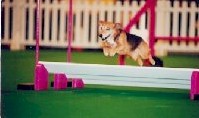 |
|
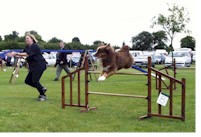 |
|
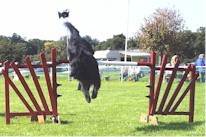 |
|
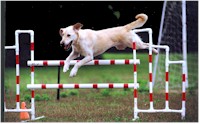 |
|
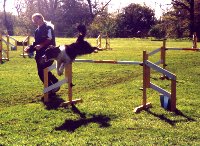 |
|
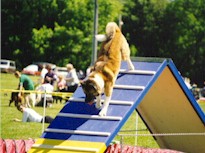 |
|
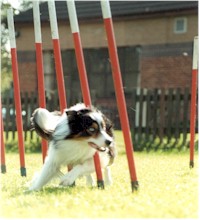 |
|
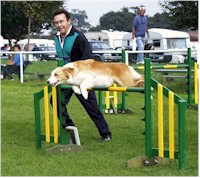 |
For those who want to read the full article go to http://www.agility.net (mind that ‘dot’!). You can check out the Dutch version (as I did) or the English one.
Advice to
reduce the risk of injuries
From all the above I have concluded that it is possible to reduce the risk of injuries
to such an extent that agility should be a fun and healthy sport, without putting your dog at
unnecessary risk. My personal view is that there are a number of things we should consider:
Equipment
Perhaps it is possible to rule that only registered trainers and judges are allowed to do these jobs, both at local clubs and at competitions. After all, if we are going to take our sport seriously, then we should do the best job possible. This would lead to more paperwork and further problems, not least in the finding of people to do these jobs in the first place, but it might be necessary to help prevent injuries.
Finally, I think that the jumping height will ultimately not make a great deal of difference to the risk of injury to the dog, as long as courses are set which are sensible and 'doable', dogs are fit and well, handlers are aware of possible problems and handle their dog accordingly and people continue to think about agility and discuss possible changes to the rules sensibly and constructively.
PS: Why do we always have all the jumps at the same height (apart from the reason that it says so in the ‘rules’!)? Horses in show jumping don’t! It forces them to look and judge each and every jump. Another can of worms?
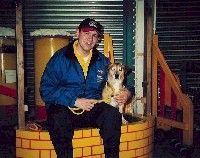 About
the author
About
the author
Peter van Dongen, Drs. (Utrecht), Cert.V.R., M.R.C.V.S qualified as a
vet at the Utrecht Veterinary school, The Netherlands, in March 1990. He worked in a mixed
practice in Louth, Lincolnshire, for three years, before moving to Borough Green, Kent. At the
same time he limited himself to small animals only.
In May 1995 Pete started agility (after years of just thinking about it!) with his Jack Russell Cross 'Basil' (a bitch!), then five years old. Since then they have qualified for many finals, including Crufts and Olympia. Basil, Peter's first and still only agility dog, is now an Advanced dog and still going strong at the age of nearly 11 years!
Peter passed the Agility Club Instructors' exam in October 1999 and has since done the Agility Club Judging Workshop.
Since December 1996 he has run a branch practice in Allington, Maidstone in Kent. Peter and his wife Carry still live in Borough Green with their two dogs and two cats.
From Lynn Anderson...
I am so pleased that Peter has pointed out just how
physically demanding the weave poles can be for dogs. I am sure most people just don't realize
the strain on the spine. The KC minimum distance between each pole of 1' 6" is far too tight
for standard dogs. Ever watched a dog such as a German Shepherd attempting poles set at the
minimum distance?
The minimum distance on the weaves for standards should be the current maximum distance of two foot. Keep your 1' 6" poles for Minis.
I am not sure that this 'Quickest 60 weaves' competition is a good idea!
From Susan Selby...
I have found the entire article most interesting, as I have not seen
much written in the relation of jumps and injuries.
I had a great Dane very sound and excellent at Agility, we discovered Spondylitis the arthritic one treated with anti inflammatory, no one seems to know much about it, at the age of three years. I was told by my vet that Spondylitis would not have been caused by Agility, but probably escalated by it.
I only had my Dane put down a few weeks ago, she was just 6 years, and I felt it the kindest thing to do, as she wanted to be active, and pain was becoming very much part of her everyday life. She was on the full dose of Rymadle. I really would be most interested in the studies on weaving and Spondylitis caused by or escalated by - or is it inherited, her hips and joints were perfect. She was trained from a pup, not jumped until she was old enough her co ordination was brilliant and she was muscled up.
I would like to hear more on this if possible. Email me on sue_sel@bigpond.com. (17/10/01)
From Martin Pollard...
Peter van Dongen’s article on jumping heights is
very well argued and a delight to read. Facts are
hard to come by, but the Utrecht report seems to combine a scientific approach and common
sense.
Jumping
One point which I think might be looked at further is frequency.
How many jumps does your dog vault a week? 50? 200? 300?
Does repetition of a specific action can injury of itself, or does it just speed up the incidence?
Other
obstacles discussed by the Utrecht report.
I have suggested possible action to find the best
way forward, but these are only my thoughts.
Peter’s suggestions for equipment
Slats
The range of solution is thick slats to no slats (or may be some other idea?)
Proposed action. Research needed to establish
compromise thickness.
Contact angles A - ramp
No problem to reduce angle, It may be that the result is either negligible or that the
safety is a maximum at one particular angle; perhaps if the included angle is too obtuse
speed increases and the safety factor decreases.
Proposed action: Tests with A-ramps at different angles.
See-saw
The FCI pivot height is 500mm, whereas our see-saws are at about 600mm.
Proposed action: Make
see-saw stand with 500mm pivot. Test speed.
Dogwalk
This could be made lower. However, same
reasoning as A - ramp, I am pretty certain
speeds will increase. I once saw a dog fall off a dog walk, result - a broken back.
Proposed action: Research using adjustable height dog walk and testing speeds.
Collapsible tyre
In my opinion very difficult to make successfully.
One problem is that if parts are made to fall away, will they tangle with the dog?
Another problem is who is going to put it back together again?
Training needed for pole pickers. Velcro
doesn’t work very well covered in thick mud. I
have made a dog wash tyre where the internal diameter is made from 4” bristle. (picture?).
I don’t think it is quite the answer but it might lead to better things.
Proposed action: Design further
‘tyres’ using safety materials and construction, make prototypes and test.
Jarring see-saw
It is obviously a good idea to absorb the energy caused by
the circular motion in the board, but is a pad a good idea?
It would have to be made in an energy absorbent material which recovered after each
impact, not easy. A springy pad might well be counter productive, driving the board upwards.
Lowering the height of the pivot would reduce the kinetic energy, a reduction in
height of 100mm at the pivot point turns into 200mm at the board end.
My idea - and I think a successful one - was to make the stand telescopic. With a rigid, staked down stand, the board hits the ground and comes to a dead stop, causing jarring as the energy escapes by taking it out on the board and stand. If the stand is telescopic, the board rotates on the end touching the ground, the centre lifts and the energy is dissipated smoothly over half a second or so.
Proposed action: Test all methods of reducing ‘emergency stop’ effect on board. Perhaps investigate training methods. A dog trained to crawl along the contact will reduce board rotational speed, and perhaps its bent legs will reduce the jarring on its body.
There is no question to my mind that agility equipment and its use can be made much safer for dogs and handlers. To do this scientifically research and testing would have to be carried out and proper designs made. There is little point in watching a few dogs and then coming up with the solution. A range of ideas should be generated by using conventional and creative problem-solving techniques, for instance Attribute listing, Analogies, Morphological matrices. (1). When using these techniques all factors are thought about; quite often the solution is very different from the first ideas.
I would be very pleased to help by carrying out a design exercise, or by making new or adapting existing equipment for testing purposes.
Source.(1) Design Principles and Practice. T204 Block 3. Open University.
NB. I can get agility.net but I can’t make it work. Is it the site or do I need clicker training?
From
Cheri Crane...
I felt the article was very interesting and
informative. I was drawn to it because of the information on how lower isn't always better. I
have a border collie who has been doing agility for 2 years and I recently found out she has
hip displasia. My vets have recommended that I continue in agility to keep her muscles toned,
as long as she feels like doing it. She's not a high-drive BC, and she does let me know when
she doesn't feel like jumping.
I have been struggling with the jump height issue, since she has to jump only 14" for UKC, but 20" for AKC and NADAC. We enjoy the later two more, but I am concerned about the higher jumps.
I would love to have information on the effects of some of the other obstacles (ie: crawl tunnel and A-frame), on a dog's hips. I don't want to cause her any further problems, but I believe the exercise is good for her, and she sure would miss it if I made her quit. (15/03/01)
From
Holly Evans...
Just happened upon this article and was very interested. Coming from
a horse background and and being new to agility, why don't we have padding on the teeter if
that would make it safer? It seems to make sense that the weave poles should be adjusted
according to height just like the jumps are .so I suppose the answer is , just like at the
racetrack, its always been done this way, so we don't change it now...
(26/02/01)
From
Melanie Behrens...
This is truly an interesting article, written by a European
veterinarian. I especially find his recommendations interesting, especially the size dependent
weave poles. When I watch my large dog weave, I know that he cannot weave as fast as a border
collie, even if he wanted to, because he is forced to bend around at least 3 poles at once. And
when you watch the small dogs weave, you realize that they are not bending around the poles at
all... and weaving is a totally different exercise for them than it is to a medium or large
dog.
I also like the idea of some shock absorbing padding on the down side of the seesaw. And his other idea is interesting, about having jumps set a different heights, requiring the dog to judge the jump height more carefully. This is an interesting way to create a new challenge in agility, that requires a dog to be a good jumper. (25/02/01)
 From
Steve Drinkwater...
From
Steve Drinkwater...
This works well for us Down Under. The Agility Dog Association of
Australia Ltd (ADAA) allows judges to set up to four Hurdles in a course at a height one below
what would normally be required for that class:-
- Maxi Class can have four (4) hurdles at Midi height.
- Midi Class can have four (4) hurdles at Mini height.
- Mini Class can have four (4) hurdles at Toy height.
- Toy Class does not use this rule.
From Ace Russell
What a great article! Finally some common sense coupled with factual
analysis. I've passed the link on to my favorite Corgi agility lists, so people can get
educated about this and follow some logical suggestions. Thanks, Peter! Job well done!
(22/02/01)
|
[bottom.htm] © Copyright Agilitynet |